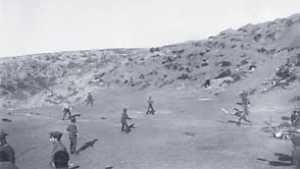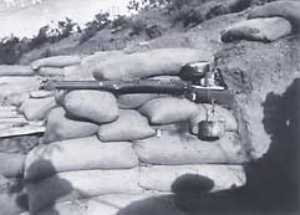Adapted from the book ‘Don't forget me, cobber!’ by Matt Anderson
Not all brave acts at Gallipoli met with success, however. The film ‘Gallipoli’ tells the story of the 10th Light Horse Regiment from Western Australia and the brave but pointless attack at a place called The Nek. After several mistakes that gave the Turks time to prepare for an attack, the Australians fixed bayonets, leapt out of their trenches and charged the Turkish lines. In just 30 seconds, the first wave of men had all been killed or wounded. The Turks eventually stopped shooting and the battlefield fell silent. The loudest noise was the heartbeat of the men who were next to go over the top.
After only two minutes, the second wave stormed from the trenches, into the wall of hot lead and steel. The final wave of ANZACs remained in the trench. They knew the attack was now pointless, and waited for the Generals down on the beach to order them to stop. But the only order they received was to attack. Brothers said goodbye to each other, and friends stood side by side. As they leapt out of the trench they jumped over the bodies of their friends who had been alive only minutes earlier, and knew they would soon join them. No ANZACs ever reached the Turkish trenches. In 1919, after the war was over, several ANZACs went back to Gallipoli to bury their dead properly. At the Nek, they found the bodies of more than 300 Australians in an area smaller than a tennis court.
After eight long months of bitter fighting, the British High Command decided that the war at Gallipoli was too costly when they were also fighting other battles in Europe. The ANZACs alone had lost 10,000 men, and so the order came for a withdrawal.
This news upset the ANZACs, as they never thought that they would leave Gallipoli until they had won. Too many of their mates had died to give up now. But the order was final. The ANZACs decided that if they had to leave, then they would do it properly. Somehow they had to sneak off the Gallipoli peninsula, right from under the noses of the Turks.
Over two weeks, 35,000 Australians were evacuated from Gallipoli. First off were the wounded, then the mules and heavy guns and equipment, and finally the soldiers. Right up until the last day the ANZACs tried to make everything look normal.
They played cricket and walked around smoking and talking in the open. They rigged rifles – ‘ghost guns’ they called them – so that they would fire after the owners had left.

Like to copy this image? Please click here first
(Above) ANZACs playing cricket at Gallipoli. (AWM G01289)

(Above) The famous ‘ghost gun’. Water dripped slowly from the top tin into the one below. The rifle fired when the bottom tin became heavy enough to pull a wire attached to the trigger. (AWM G01291)
And night after night they wrapped sandbags around their boots and quietly made their way down to the beach for evacuation. “No talking, lads, no smoking,” they were told by their sergeants.
Many stopped by the graves of brothers, mates, even fathers, and hoped those buried far from home couldn’t hear them leaving.
News of the terrible losses at Gallipoli was printed daily in the newspapers back home in Australia. Included in these lists were the names of the fathers, brothers and mates now buried, or missing, on the peninsula. But instead of making Australians too frightened to enlist, the news did the opposite. In July 1915, when the casualty figures coming back from Gallipoli were at their worst, more than 36,000 men volunteered. (This is more than in the whole Army today 1998!) Veterans of Gallipoli called these men the ‘fair dinkums’. “Any man who volunteers after knowing the horror of Gallipoli must be fair dinkum,” they said.





